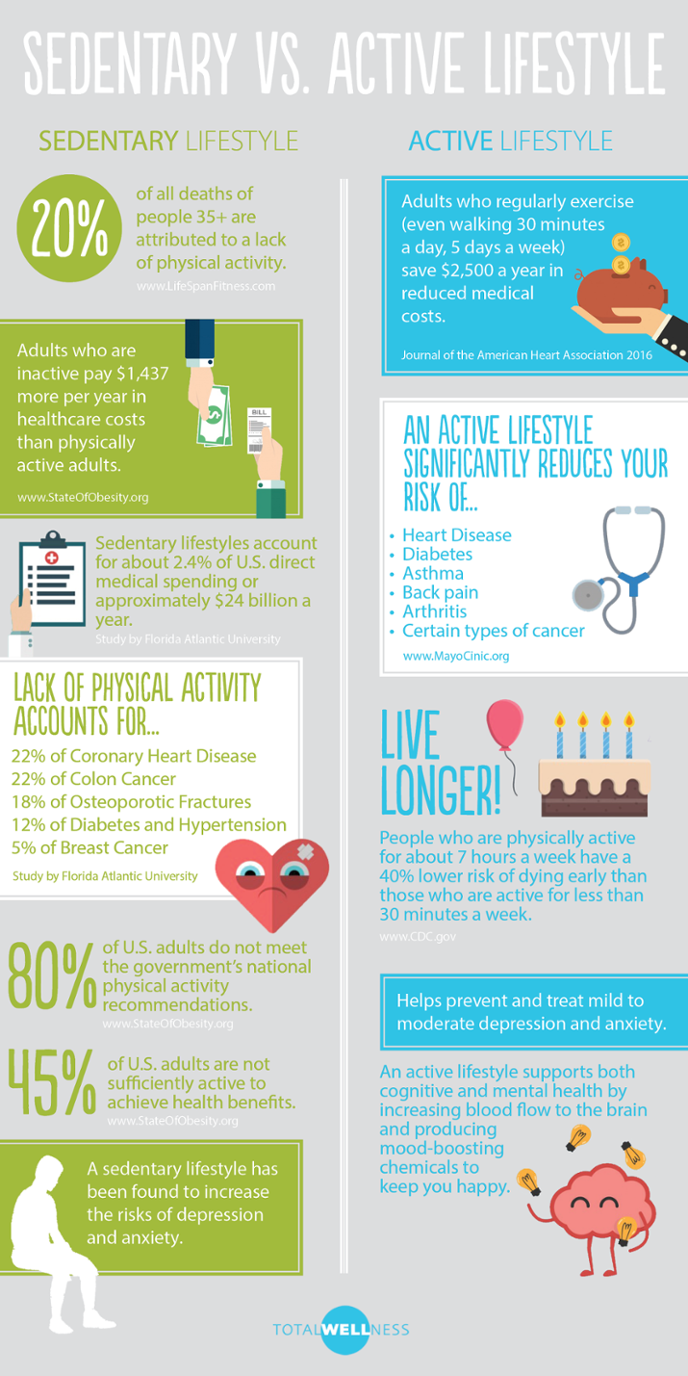One of the worst things you can do to your body is doing nothing at all and unfortunately, a sedentary lifestyle has become the norm in our culture. Sitting all day and leading an inactive lifestyle can have harmful, long-term effects to your employees’ health. According to Mayo Clinic, 50-70 percent of people sit at least six hours per day, and 20-35 percent of people spend over four hours every day watching TV.
With more than one-third of U.S. adults living with obesity, it’s more important now than ever to educate your employees on the effects of sitting too much and start working towards an active lifestyle. Check out this infographic below to learn a bit more about how a sedentary lifestyle affects the health and quality of life of your employees:

While a sedentary lifestyle can seem scary, the truth is there are a lot of things you can do to avoid these negative effects. It’s been shown that simply breaking up the time you spend sitting and focusing more on moving throughout the day can reverse the effects and help you become healthier overall.
As an employer, you have the power and resources to help your employees get moving. One of the easiest ways to do this is by encouraging them to walk more. Walking is an effective and simple way to get back into shape and stay in shape. Research has shown that regular walks help reduce the risk of chronic disease, control weight, and increase energy and productivity – just to name a few!
If you want your employees to be healthier, you want them to move more. But how can you promote walking in a traditional office space? Here are a few ideas for you:
Educate. First, start by educating your employees. You can’t encourage your employees to move more during the workday if the foundation isn’t there. Explain how walking is one of the most simple and effective forms of physical activity. Make sure your employees understand that they can be of any age or fitness level to benefit from walking. Provide your employees with the resources and education they need about the benefits of walking. Once informed, employees will be more inclined to get moving on their own!
Walk and talk. I love the idea of walking meetings. A walking meeting is an active replacement for a typical one-on-one cup of coffee or conference room chat. The benefits of this type of meeting are both physical and psychological – not to mention it’s a lot more fun than sitting in a stuffy conference room. Try taking a stroll with your employee the next time you have a less-formal meeting or discussion.
Start a walking club. Walking clubs help your employees move more and socialize at the same time. A simple 15-minute walk in the company parking lot will help your employees perk up when they’re facing that afternoon slump. Try dividing up walking clubs by team or division for some friendly competition. The team with the most participants or more walks after six months can win a prize!
Create challenges. Start thinking of some daily, weekly, or monthly walking challenges for employees. Challenge them to only take the stairs and skip the elevator for a full week. Challenge them to park in the furthest area of the parking lot for a month. You can offer incentives to employees for participating in these types of challenges.
Make it fun. Walking doesn’t always sound like the most exciting activity. Try to jazz it up! Make a company map to show the different walking routes employees can take in and around your building. Host a party for employees who participate in walking clubs and challenges. Post motivational signs next to the stairs with fun graphics to encourage employees to skip the elevator. You can even post success stories on your company website featuring employees who have changed their lifestyle from walking more and sitting less.
Incorporate wearables. Between Fitbits, Garmin, and Apple Watches, wearables are all the rage. Chances are, many of your employees already have some sort of fitness tracker or a device that is capable of tracking steps. Start incorporating these wearables into company culture and walking challenges. If your budget allows for it, fitness trackers can also serve as an awesome incentive to get your employees moving.
If you want your employees to move more, encouraging walking is a simple and effective first step. Try out some of these ideas to help your employees step out of their cubicles and get some steps in. You’ll get some healthier (and happier) employees out of it!